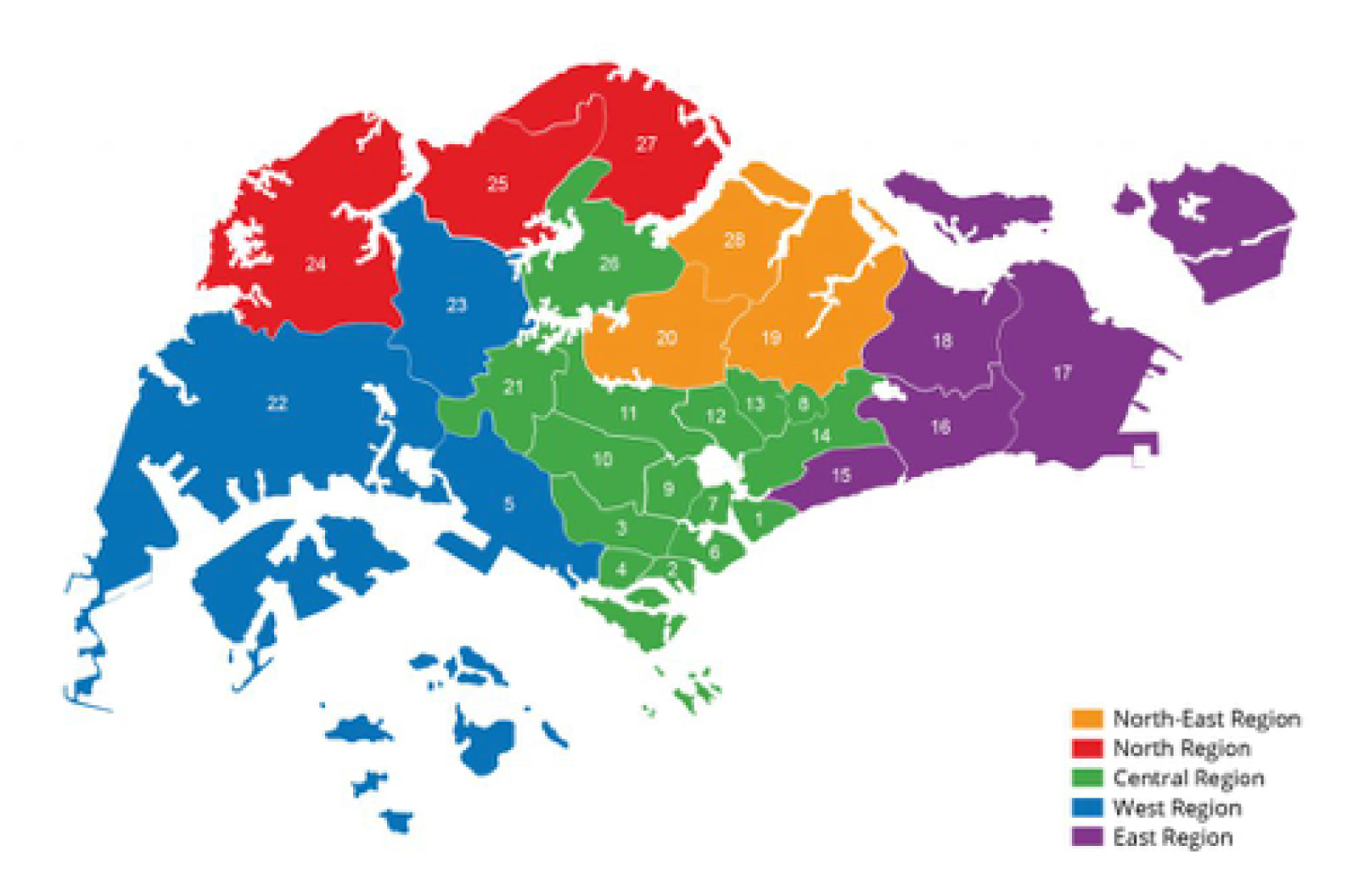How to rent an apartment in Singapore?
After you decide to move to Singapore, one of the most significant challenges is finding accommodation that fits your needs and requirements. Here is some information on how to rent a flat or house in the Lion City.
City Areas
Singapore might be one of the smallest countries in the world, but it has a well-developed infrastructure with multiple areas. Numerous factors can affect your preferences on where to stay, such as office location, school or preschool availability if you move with children, distance from Singapore MRT stations, etc.
Singapore is divided into five regions, which consist of 28 districts.

Singapore map. Picture: iProperty.sg
|
Region |
District |
Areas |
|
Central Region |
1 |
Raffles Place, Marina Square, Boat Quay, Suntec City |
|
2 |
Tanjong Pagar, Chinatown, Shenton Way, Anson |
|
|
3 |
Tiong Bahru, Queenstown, Alexandra |
|
|
4 |
Harbourfront, Keppel Road, Mount Faber, Sentosa, Telok Blangah |
|
|
6 |
City Hall, Beach Road (part), High Street |
|
|
7 |
Bugis, Rochor, Middle Road, Bencoolen, Beach Road (part), Golden Mile |
|
|
8 |
Little India, Farrer Park |
|
|
9 |
Orchard, River Valley, Cairnhill |
|
|
10 |
Bukit Timah, Holland Road, Tanglin Road |
|
|
11 |
Novena, Thomson, Newton, Watten Estate |
|
|
12 |
Toa Payoh, Serangoon, Balestier |
|
|
13 |
Macpherson, Braddell, Potong Pasir |
|
|
14 |
Geylang, Eunos, Paya Lebar, Kembangan |
|
|
21 |
Clementi Park, Upper Bukit Timah, Ulu Pandan |
|
|
26 |
Upper Thomson, Springleaf |
|
|
West Region |
5 |
Pasir Panjang, Hong Leong Garden, Clementi New Town |
|
22 |
Jurong |
|
|
23 |
Hillview, Dairy Farm, Bukit Panjang, Choa Chu Kang |
|
|
East Region |
15 |
Katong, Joo Chiat, Amber Road |
|
16 |
Bedok, Upper East Coast, Eastwood, Kew Drive |
|
|
17 |
Loyang, Changi |
|
|
18 |
Tampines, Pasir Ris |
|
|
North-East Region |
19 |
Serangoon Garden, Hougang, Punggol |
|
20 |
Bishan, Ang Mo Kio |
|
|
28 |
Seletar |
|
|
North Region |
24 |
Lim Chu Kang, Tengah |
|
25 |
Kranji, Woodgrove |
|
|
27 |
Yishun, Sembawang |
Each region has its pros and cons. The central area is close to the city core, central business district and many tourist attractions. In the western part, a crucial commercial centre is budding; this is where Jurong East is located. The eastern region is close to Changi Business Park and Singapore Changi Airport; The northeastern part is a mainly residential area, and the northern region is more intimate to the border with Malaysia.
Accommodation types
Here are three types of housing available in Singapore:
HDB flats
These are public housing managed by the Housing and Development Board of Singapore. Commonly referred to as HDB.
Approximately 79% of the residents live in public housing. The housing estates usually have preschools, schools, supermarkets, clinics, hospitals, food courts (hawker centres) and sports facilities.
Condominiums
If you enjoy strata living and higher-class housing estates, you can choose the condominiums, which usually provides 24-hour security service, swimming pools, gyms and barbecue pits.
Private houses
Even though in this land-scarce country, there are still many landed houses available for rent. These also include traditional shophouses in the city centre or terrace houses and bungalows in the lush green estates in the northern region of Singapore.
Renting the whole unit or just a single room is another option you can consider, depending on your budget.
Rent Prices
Just as any developed countries, rent prices tend to be lower the farther you are from the city centre. Nevertheless, the price also depends on the type of housing, size, furnishings, and distance from transportation and amenities. Unsurprisingly, the rent prices will vary between units in the same estate.
In general, the price of renting a bedroom of a shared apartment starts from S$800. Rental of a one-bedroom flat usually starts from S$1700 per month.
Finding an Accommodation
To find a property to rent, you can refer to property websites, go through property agents, or search in Facebook groups and forums.
The most popular property websites in Singapore are:
- PropertyGuru https://www.propertyguru.com.sg
- 99.co https://www.99.co
- iProperty https://www.iproperty.com.sg/rent/
- Gumtree https://www.gumtree.sg
- STProperty https://www.stproperty.sg
- SRX Property https://www.srx.com.sg
- Singapore Expats Forum https://www.singaporeexpats.com
The fastest and hassle-free way is to engage a housing agent’s service. The agent hunt for the house or room according to your budget, bring you for viewing and facilitate the tenancy agreement process.
Property agent fees
Note that for rental of housing in Singapore, agents can collect fees from only one party – either the landlord or the tenant. If the agent works for the landlord – you don’t have to pay any fees, but you would only view properties of landlords with whom agent works.
If you want an agent to look for properties without connections to specific landlords, you must pay the agent’s commission yourself. Usually, it starts from half of the 1-month rental for the accommodation you rent eventually. The commission depends on the length of the lease.
Sometimes you can find ads from landlords directly on forums or Facebook groups, which is the cheapest alternative, but you are on your own.
For someone who wants to settle into their lodging fast, they should consider engaging a housing agent.
Renting Procedure
Once you find the place you want to rent, you should go through the following procedures:
1. Make an offer
In this stage, you can bargain about the price and confirm your intentions with the owner.
2. Sign a Letter of Intent
The letter confirms your intention to rent the place from the landlords and indicates that he will stop searching for tenants. Before signing, you should negotiate all the rental terms and conditions, such as repairs and maintenances that you will be responsible for, minimum lease term, security deposit, etc.
Often you need to pay the good faith deposit together with the Letter of Intent. This payment goes towards your security deposit after you sign the tenancy agreement. The security deposit is usually one (1) month’s rental for a one-year lease or two (2) month’s rental for a two-year contract.
Make sure you fully understand your liabilities and the landlord’s recourse in the tenancy agreement.
3. Sign the tenancy agreement
4. Pay the rent
Be sure to pay on the date agreed in the agreement. Usually, you need to pay by a bank transfer from a local bank account. If you do not have an account, learn how you can open a bank account.

